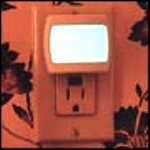Search engine visitors - click here to access entire "$ensible Home" web site
Click here to see a descriptive illustration of several new types of efficient night lights.
Dear Jim: I want to use night lights in my children's bedrooms and in hallways when I have guests. I saw some bright contemporary ones that glow green and use no electricity. What other new types are available? - H. J.

A: Even without children, a home should use night lights for safety. The newer lights have built-in photosensors, so they come on only at night. One model has a sound sensor to switch it on when it detects a person moving.
The contemporary, green glowing "Lime" night light actually does use some electricity. At only .07 watts, for 24 hours, seven days per week, it uses about two cents worth of electricity per year. I use one in my hallway and the soft green glow is soothing to the eye at night.
Its entire electroluminescent surface softly lights a large area. The Lime Light is safe around children because it stays cool. It is only one-quarter inch thick, so it is difficult for children to pry from the wall outlet. Another safety night light has a child-resistant cover over the lower outlet.
A combination 60-watt and 7-watt night light is built into a single bulb for standard lamps or fixtures. When the light is switched on, it is a bright 60 watts. Within 20 minutes, it gradually dims to a 7-watt night light. By flipping the switch twice, it goes immediately into the night light mode.
There are several other new programmable standard size light bulbs. An electronic chip is built into the base of each light bulb to produce different functions. These light bulbs, called "Smart Bulbs" or "IQ Lighting", have soft start so they last twice as long as ordinary bulbs.
Another one of these bulbs turns itself off automatically after 10 or 30 minutes. This is ideal for garages or children's rooms where lights are often accidentally left on. Flipping the switch twice makes the light stay on.
A dimmer is built into another one of these bulbs so no dimmer switch needs to be installed. By flipping the switch one, two, three or four times, the light dims from 100 watts to 20 watts in steps. A safety bulb has a built-in 20-watt backup bulb in case the main 90-watt filament burns out.
Most typical small night lights use either a four or seven-watt bulb. For a brighter light, there is a series of night lights with efficient 7-watt fluorescent mini-tubes. These give off as much light as a standard 20-watt bulb. Some models have adjustable shades to direct and dim the light.
There are also many theme shaped night lights available for children - colored crayons, clam shells, pencils, baseballs and gloves, Peanuts and Flintstone characters, etc.
Instant Download Update Bulletin No. 919 - buyer's guide of new green-glow, fluorescent and theme night lights and "smart" standard, programmable light bulbs listing prices, wattages, features, cost to operate chart and many illlustrations.
Dear Jim: I am planning to build a house and want to use staggered 2x4 studded walls. This will allow for two layers of insulation and no stud in contact with both the inside and outside walls. Is this good? - T. L.
A: Staggered stud wall construction (studs offset under a wide header) does eliminate the indoor to outdoor thermal bridge (no insulation) through the studs. This is effective on walls with few windows or doors.
On walls with many windows, the studs create thermal bridges around each window. Studs must line up for the window framing. A better idea would be to use 2x6 studs and a layer of rigid foam insulation sheathing on the outside. This covers the entire wall eliminating most thermal bridges.